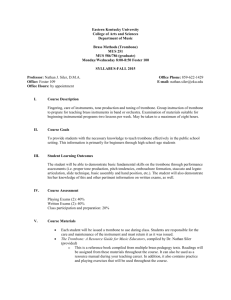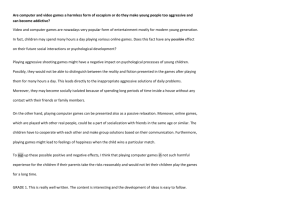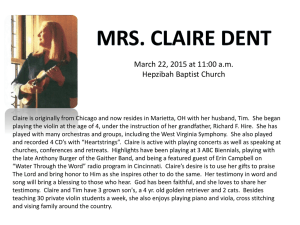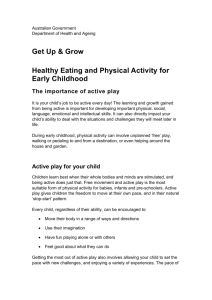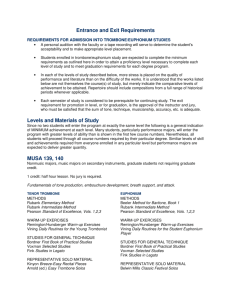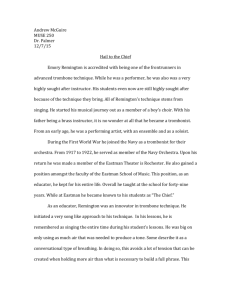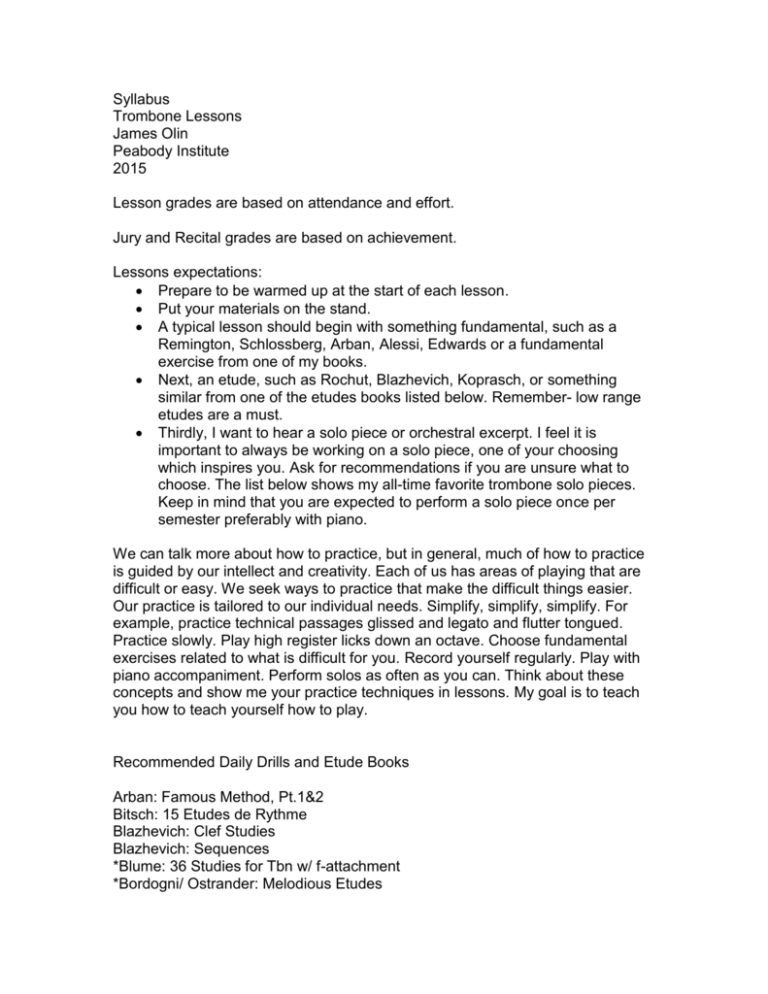
Syllabus
Trombone Lessons
James Olin
Peabody Institute
2015
Lesson grades are based on attendance and effort.
Jury and Recital grades are based on achievement.
Lessons expectations:
Prepare to be warmed up at the start of each lesson.
Put your materials on the stand.
A typical lesson should begin with something fundamental, such as a
Remington, Schlossberg, Arban, Alessi, Edwards or a fundamental
exercise from one of my books.
Next, an etude, such as Rochut, Blazhevich, Koprasch, or something
similar from one of the etudes books listed below. Remember- low range
etudes are a must.
Thirdly, I want to hear a solo piece or orchestral excerpt. I feel it is
important to always be working on a solo piece, one of your choosing
which inspires you. Ask for recommendations if you are unsure what to
choose. The list below shows my all-time favorite trombone solo pieces.
Keep in mind that you are expected to perform a solo piece once per
semester preferably with piano.
We can talk more about how to practice, but in general, much of how to practice
is guided by our intellect and creativity. Each of us has areas of playing that are
difficult or easy. We seek ways to practice that make the difficult things easier.
Our practice is tailored to our individual needs. Simplify, simplify, simplify. For
example, practice technical passages glissed and legato and flutter tongued.
Practice slowly. Play high register licks down an octave. Choose fundamental
exercises related to what is difficult for you. Record yourself regularly. Play with
piano accompaniment. Perform solos as often as you can. Think about these
concepts and show me your practice techniques in lessons. My goal is to teach
you how to teach yourself how to play.
Recommended Daily Drills and Etude Books
Arban: Famous Method, Pt.1&2
Bitsch: 15 Etudes de Rythme
Blazhevich: Clef Studies
Blazhevich: Sequences
*Blume: 36 Studies for Tbn w/ f-attachment
*Bordogni/ Ostrander: Melodious Etudes
Bordogni/ Rochut: Melodious Etudes, Bk.1-3
Boutry: 12 Etudes de haut Perfectionnement
Cimera: 55 Phrasing Studies
Concone: Legato Etudes
*Gillis: 20 Etudes
*Gregoriev: 24 Studies
Kopprasch: 60 Selected Studies
*Kopprasch/ Fote: Selected Studies for Trombone with f-attachment
LaFosse: Vade Mecum
*Maenz: 20 Studies for Bass Trombone
Mantia: Trombone Virtuoso
Marsteller: Basic Routines
Mueller: Technical Studies, Bk.1-3
*Ostrander: Melodious Etudes for Bass Trombone
Paudert: 24 Studies
Pottag & Andraud: Selected Melodious, Progressive and Technical Studies,
Bk.1&2
Remington: Warm-up Studies
*Schroeder: Foundation Studies for Cello, Bk.1
Schlossberg: Daily Drills and Technical Studies
Smith: Top Tones for the Trumpeter
Slama: 66 Basic Studies
Vernon: Singing Approach to Trombone
Vobaron: 34 Etudes
Voxman: Selected Studies
*Good low range books.
Favorite Trombone Solos
*Albrechtsberger: Concerto for Alto Trombone
C. P. E. Bach/Ostrander: Advanced Studies
J. S. Bach: Cello Suites
J. S. Bach: 3 Sonatas for Viola da Gamba
Bassett: Sonata
*Bassett: Suite
Berio: Sequenza
*Besozzi: Sonate
*Bloch: Symphony for Trombone
*Bourgeois: Concerto
Bozza: Hommage a Bach
Brahms: 4 Serious Songs
Brahms: Sonata in e-minor for Cello & Piano
*Casterede: Sonatine
Crespo: Improvisation
*Creston: Fantasy
David: Concertino
*Defaye: Deux Danses
*Dutilleux: Choral, Cadence and Fugato
Dvorak: Biblical Songs
Ewazen: Sonata
Galliard: 6 Sonatas for Bassoon
Grondahl: Concerto
Guilmant: Morceau Symphonique
Handel/Brown: Concerto in f- minor
Hidas: Fantasia
*Hidas: Movement
Hindemith: Sonata
*Jacob: Concerto
Jongen: Aria et Polonaise
Larsson: Concertino
Mahler: Songs of a Wayfarer
Marcello: 6 Sonatas for Cello
*Martin: Ballade
Milhaud: Concertino D’hiver
Mozart, W.A.: Concerto K. 191 for Bassoon
*Mozart, Leopold: Concerto
*Peaslee: Arrows of Time
Pergolesi: Sinfonia Pryor: All
Rachmaninoff/Alessi: Elegy
Rachmaninoff: Vocalise
*Ropartz: Piece in b-flat minor
*Rota: Concerto
Sanders: Sonata in E-flat
Saint-Saens: Cavatine
*Salzedo: Piece Concertante
Shostakovitch: 4 Preludes
Serocki: Sonatina
Spillman: Two Songs for Tuba
Stevens: Sonata
Sulek: Vox Gabrieli
*Telemann: Concerto for Trumpet in D-major
Telemann: Sonata in f-minor
Telemann/Raph: 12 Fantasies
*Tomasi: Concerto
Vaughan Williams: 6 Studies in English Folksong
Vivaldi: 6 Cello Sonatas
*Wagenseil: Concerto
*Walker: Concerto
Weber: Romance
White: Sonata
*Especially good for high register.
The following outlines some of my thoughts about teaching and playing the
trombone.
Philosophy of Teaching and Playing
By James Olin
Introduction:
My philosophy of teaching is essentially derived from this “given” - that there
exists in us a love for making music and for playing the trombone.
In order to know how to teach, we must know who is being taught so that we can
decide what to teach. Before dismissing this notion as obvious, consider the
importance of knowing the student’s age, present playing level, and, most
importantly, the objectives and goals of the student.
If you as the teacher do not know the specific goals of your student, or you do not
know why he or she is studying with you, then ask! A typical first lesson might
include playing a simple duet, and then asking the student what it is he or she
hopes to gain from the lesson with you. By then you will have an idea of the
playing level of the student, and the diversion of sight reading a duet will put him
or her at ease.
In the teaching of applied trombone, whether at an advanced or primary level, we
also should ask the question, “Why do we play the trombone?” We should point
out that playing the trombone is fun!; otherwise why would we be studying and
practicing?
Making playing fun depends on:
a) choosing practice material that is challenging
but not too difficult,
b) providing different types of music- not only daily drills and
etudes, but also solos and orchestral excerpts,
c) allowing the student to
progress at his or her own rate.
Allow the student to excel at a rate that matches the student’s ambitions at the
moment. I have found that pushing (or pulling back too much) a student’s own
rate of progress can be counter productive, especially if you exhibit frustration
that the student’s expectations do not match your own. It is difficult for me to
discourage a player as long as I know that the student is enjoying playing.
Trombone playing can even be thought of as therapy! It makes you feel good.
I am not implying that teaching is so blissful that every student will think that they
will get a job playing in a major orchestra. I try to make clear that a person’s
goals should be realistic, and that they should include alternative plans, in case
longterm goals are not met within a reasonable period of time. Many jobs in
music can be rewarding. Being the best musician you can be is the key.
The following outline describes specific ideas and techniques, which I use in my
teaching. The underlying theme of my teaching is “teach yourself how to play.” In
other words, become your own teacher. If a student continually tries to teach
himself/herself techniques for self-improvement and learns to be independent
from his or her major teacher, then the improvement of the student can progress
at the most satisfactory rate and become a lifelong pursuit of excellence.
An Outline of Basic Concepts:
Breathing
a) Breathing is natural.
b) Breathing should be relaxed, with your body limp.
c) A breathing tube helps to simulate saying the syllable “HO.”
d) Take in ample air (more than you think you will need).
e) The respiratory system is like a bellows- it rises and falls very easily
and naturally.
f) Expel air without locked muscles. Do not work against yourself.
g) Do not push or hold your stomach out.
h) Fill up as if you are yawning. Allow your entire torso to move up and
out.
i) Put your hand on all areas of the chest in order to feel the even and
natural expansion and collapse.
j) The sound of inhalation should be deep and quick and open.
k) Inhale the air into your mouth.
l) Practice starting notes without tonguing. Do not articulate with the throat
as you might do when whistling.
m) Do not tense the large muscles of your body as if doing isometrics.
l) Practice blowing air out with little or no effort like a sigh, or a sigh will
speed. Then add light articulation.
m) Try incorrectly blowing air out by using large muscles (forcing); then
collapse and feel the difference. Forcing and collapsing are opposites. It is
impossible to collapse and force at the same time.
n) When blowing, think of the air stream as thick and slow. Think of an
open aperture.
Sound (tone)
a) Concept
1) Think of the greatest, smoothest, most exact, beautiful sound that could
ever be, and imitate it.
2) Always pretend you are playing for someone, even if you are not.
Visualize playing in front of an audience while practicing.
3) Do not fool around (making funny noises into the horn).
4) Concentrate on the beauty of the tone, and always strive for a singing
quality.
5) Think of an efficient, resonant and effortless sound.
6) Make a beautiful sound from top to bottom. Let the low teach the high.
7) Your ideal sound and a relaxed intake of air should be the only things
you think about just before playing.
8) Open the throat cavity for a bigger, clearer core of dark, centered
sound. A covered sound is OK for some things, but be aware of it and
work toward a clearer sound.
9) The sound should be consistent at all volumes.
10) A good sound is dependent on good intonation, since the slide must
be at the proper length for the desired pitch.
b) Embouchure
1) There is no single embouchure that is right for every player. Often too
much attention is given to analyzing embouchure.
Let the sound be your
guide.
2) Allow yourself to find the proper mouthpiece placement for you.
Mouthpiece buzzing and free buzzing can help find the best setting. Try
turning the horn around backwards and playing left handed if you wish to
dispel old habits.
3) General suggestions:
-Puffing of cheeks should be avoided.
Smiling or spreading the lips
out horizontally when playing in the upper register will limit
endurance and can deter the development of a clear sound.
c) Tonguing
1) Tongue in the mouth where you say “T.”
2) For an open sound, the syllables “TOH” or “TAH” are best.
In the
lower register, tonguing between the teeth is fine.
3) Exercises that help to increase the speed of the tongue also help
consistency and lightness in tonguing.
d) Legato
1) Use natural (lip) slurs whenever possible.
2) Monitor the air stream by glissing legato passages (without
exaggerating smear); then clean up glissed intervals with soft “DAH”
tongue.
3) As a general rule, seek out natural slurs on intervals greater than a half
step, and play half step intervals on the same partial. Of couse, always
employ the technique that produces the best final product.
4) Slide arm should be relaxed and quick. An overly fast or jerky arm
motion contributes to tension in the body, the interruption of a smooth
airstream and a choppy legato.
Intonation
a) Playing in tune with yourself requires a good sense of relative pitch.
Practicing slow scales helps relative pitch. Well tempered intonation can
be improved through the use of a tuner.
b) Playing in tune with others requires one to have the attitude that no
one’s pitch is perfect, and that anyone may have to adjust in order to tune
a chord. An orchestra or band brass section may be thought of as a
hierarchy, where the section players tune to the principal players, and the
principal horn and trombone tune to the principal trumpet and tuba.
c) Studying deviation from equal temperament in order to achieve pure
temperament is interesting and helpful, but it is not a substitute for your
willingness to listen.
d) When adjusting a pitch, trombonists can maintain a consistent sound,
since we do not need to “lip” notes in order to adjust their pitch. Simply
adjust the length of the slide, rather than changing the breath support or
allowing the embouchure to pinch or sag.
Rhythm
a) Good rhythm is a skill that can be learned.
b) Rhythm is an absolute- that is, it is either right or wrong; there is no
middle ground. Exceptions include stylizing and rubato.
Musicality
a) Listen to as much music as you can. Attend recitals. Listen to your
friends and peers. Repeated listening to music of a certain style or era
teaches you what is an appropriate musical interpretation. Imitate the
best.
b) A musician’s instrument is the vehicle for the expression of a musical
idea.
c) Even on simple melodies, play as if you are bringing across a musical
message.
d) Focus on your musical ideas. Try to forget the mechanics, and
concentrate on phrasing and line. Don’t play by feel. Try to think only
about the music statement.
Style
a) Take pride in your ability to play different styles in music.
b) Learn the different styles by listening and imitating, so that your
interpretation of each musical style is appropriate.
c) Constantly ask yourself the question, “What can I do to add character to
the style of the piece?” In ensemble playing, this includes issues of
balance.
d) Use vibrato whenever you can get away with it. Vibrato is a must for
solo playing. Use it constantly in your practice. Think of vibrato as part of
your sound.
Practice- there is no substitute
a) Think of warming up as making music. Make music in your warm up.
b) Diagnose your own problems. Practice what needs improvement.
c) Maintain the physical skills that have been built up.
d) Correct known weaknesses by simplifying and setting small achievable
goals. Then slowly increase speed or range.
e) Try free buzzing and mouthpiece practice. Play simple tunes at first,
then easy slurs and basic scale patterns.
f) Remember to play every note of sound just the way you would like to
hear it.
g) Be your own critic. Do not idolize one teacher or one player so much
that you lose your individuality. A variety of teachers can be good.
h) Audition committees tend to prioritize in the following order:
1) Sound
2) Intonation and rhythm
3) Musicality and style
Once the final group of candidates is chosen (with great sound,
intonation and rhythm), the winner will be the one who plays the most
musically and stylistically.
Becoming an Artist
Bypass the physical complexities of playing, in order that the art of playing
can be simple and sound effortless (Wind and Song).
Shed inhibitions; allow musical ideas to come out.
Use musicality and expressiveness to stand out from the crowd.
Be creative. Know what you want to say and say it. Have a plan and
execute it.
Excellence is your norm, not an exception. Every moment on the horn
counts.
Practice everything this way, producing the greatest music possible, one
beautiful sound after another.
Copyright © 2014 James Olin. All Rights Reserved.

